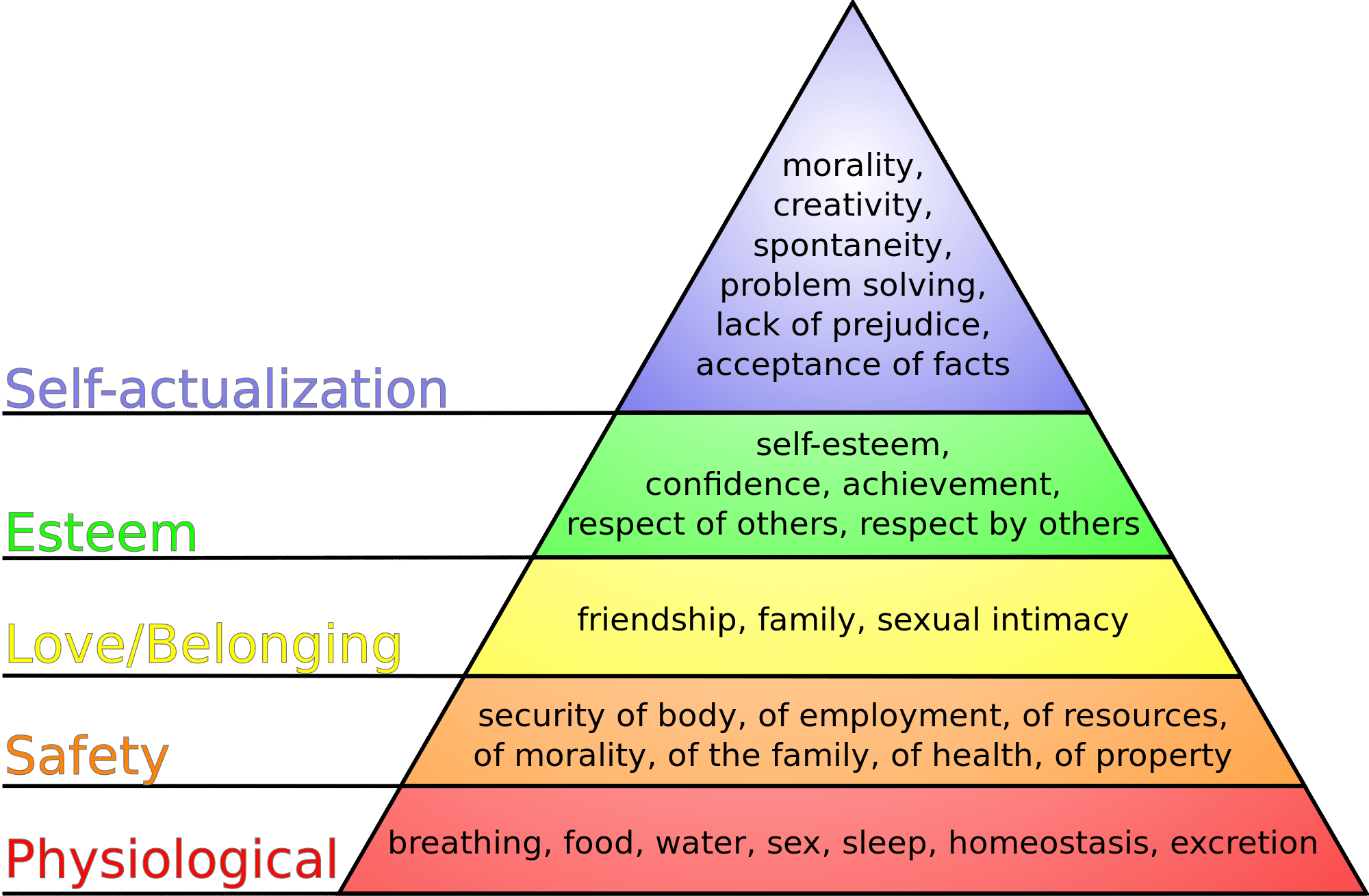It has been established that users are more likely to choose products that meet their needs than ones that meet their wants. Abraham Maslow developed a deep understanding of human needs and how they could be met. You can use Maslow’s Hierarchy of Needs in a design context to deliver more powerful user experiences that meet user needs rather than user wants.
If you want your users to accept your products they need to be motivated to do so. Abraham Maslow’s, the American psychologist, most famous research examined human motivation. In 1943 he published his paper; “A Theory of Human Motivation.” In this paper he revealed his understanding of human needs and proposed that they formed a hierarchy from the most basic to the most complex.
He suggested that in order for a human being to be satisfied they must take of all their needs. However, the most basic needs must be fulfilled before higher level needs can be met satisfactorily.
From the Bottom Up – The Hierarchy of Needs

Author/Copyright holder: J. Finkelstein . Copyright terms and licence: CC BY-SA 3.0
Physiological Needs – The most basic needs of all are those that are needed to sustain us as individuals and as a species. They include food, drink, shelter, breathing, sex, comfort and sleep.
Safety Needs – The next level of needs to be met are those that offer us some guarantee of being able to satisfy our physiological needs in the long-term. These include fiscal and personal security, health, protection from the elements, etc.
Social (or Love and Belonging) Needs – The human animal is a social one and there is a deep-seated requirement for company in life. Social needs include friends, lovers, intimacy, families, communities, relationships and a sense of belonging.
Esteem Needs – Basic social needs become more complex for people and there is a need for our efforts to be recognized by others. Esteem needs may be fulfilled by social status, achievements, mastery, prestige, etc.
Self-Actualized Needs – The final, top layer of the hierarchy, is associated with our ability to grow as an individual. These needs include peace, contentment, self-growth, maximum experiences, etc.
When a lower level of need fulfilment is not in place; it is technically possible to be fulfilled at a higher level. However, this is seen by Maslow as an unstable fulfilment. If you’re starving it doesn’t matter if you’re seen as the world’s leading physicist, for example, eventually your hunger is going to overwhelm any satisfaction you get from your professional status.
We naturally seek to stabilize the lowest level of the hierarchy that is uncertain before we try to retain higher levels.
But Is Maslow Right?
It’s difficult to say that Maslow is 100% correct. There are many criticisms of the hierarchy of needs. In particular; he completely ignored spiritual needs in the pyramid (though many would argue that spiritual fulfilment is a manufacture need rather than an intrinsic human need).
It also fails to account for acts of altruism where a person puts another’s needs ahead of their own. These acts may be “selfish” acts (such as a parent’s sacrifice for a child) which can be explained logically or completely “unselfish” (such as when an individual sacrifices themselves for a stranger) which are harder to explain. However, it would seem pretty clear that these actions are driven by needs outside of the pyramid.
Finally, it’s also worth noting that Maslow’s hierarchy lacks social context. In Western societies it is common for individual needs to be prioritized over the needs of a society as a whole. In many Asian cultures, for example, this is completely reversed. “Face” as a concept comes from a need to serve society before the individual.
The Hierarchy of Needs in Design Terms

Author/Copyright holder: Jon and Barb . Copyright terms and licence:CC BY 2.0
Stephen Bradley, writing for Smashing Magazine, proposes that Maslow can be used as a template for design needs too. He abandons Maslow’s hierarchy and replaces it with a new one
The Design Hierarchy from Bottom to Top
As with Maslow’s hierarchy it is essential for a design to meet the lowest need on the pyramid before progressing to meet further needs.
Functionality – for a design to meet any need it must work and it must meet the basic needs of the user. However, if this is all it does; it may well be seen as having little value if any to the user in the short to long-term.
Reliability – the next step is for your design to function in a reliable manner and present a consistent experience. This may increase the user’s perception of the value of your product from a purely functional one but it does not add large amounts of value either.
Usability – then a design should be simple to use and relatively forgiving of user error. When you meet this need the product is likely to be considered of middling value by the user.
Proficiency – a design which helps a user to do more or achieve more is one which is likely to be desired as a high-level of value and fulfil user needs more effectively.
Creativity – the final step in the design pyramid is to create products which fulfil all other needs and are beautiful not just in form but also in interaction and function. This is where the highest user value is placed (think Apple products for an example in real life).
The Take Away
Maslow’s original hierarchy of needs may not be directly related to design. However, as Stephen Bradley demonstrates it may be amended to give a very useful guide to developing products which deliver high-levels of value to the user. Keeping the design hierarchy of needs in mind during your own design projects will result in better user experiences.
References & Where to Learn More
Course: “User Experience: The Beginner's Guide”
Stephen Bradley’s original piece for Smashing Magazine may be found here.
You can read Maslow’s original paper “A Theory of Human Motivation” online here.
Hero Image: Author/Copyright holder: Rosenfeld Media. Copyright terms and licence: CC BY 2.0











